Journal of Southern Medical University ›› 2025, Vol. 45 ›› Issue (2): 359-370.doi: 10.12122/j.issn.1673-4254.2025.02.17
Yu BIN1( ), Ziwen LI1, Suwei ZUO1, Sinuo SUN1, Min LI2, Jiayin SONG2, Xu LIN1, Gang XUE2(
), Ziwen LI1, Suwei ZUO1, Sinuo SUN1, Min LI2, Jiayin SONG2, Xu LIN1, Gang XUE2( ), Jingfang WU1(
), Jingfang WU1( )
)
Received:2024-11-06
Online:2025-02-20
Published:2025-03-03
Contact:
Gang XUE, Jingfang WU
E-mail:binyuyouxiang@163.com;641426767@qq.com;wjfxg@163.com
Yu BIN, Ziwen LI, Suwei ZUO, Sinuo SUN, Min LI, Jiayin SONG, Xu LIN, Gang XUE, Jingfang WU. High expression of apolipoprotein C1 promotes proliferation and inhibits apoptosis of papillary thyroid carcinoma cells by activating the JAK2/STAT3 signaling pathway[J]. Journal of Southern Medical University, 2025, 45(2): 359-370.
Add to citation manager EndNote|Ris|BibTeX
URL: https://www.j-smu.com/EN/10.12122/j.issn.1673-4254.2025.02.17
| Gene | Sequence |
|---|---|
| APOC1 | F:5'-CTGGTGGTGGTTCTGTCGAT-3' |
| R:5'-TCACTCTGTTTGATGCGGCT-3' | |
| β-actin | F:5'-CCTGGGCATGGAGTCCTGTG-3' |
| R:5'-AGGGGCCGGACTCGTCATAC-3' |
Tab.1 Primer sequences for RT-qPCR
| Gene | Sequence |
|---|---|
| APOC1 | F:5'-CTGGTGGTGGTTCTGTCGAT-3' |
| R:5'-TCACTCTGTTTGATGCGGCT-3' | |
| β-actin | F:5'-CCTGGGCATGGAGTCCTGTG-3' |
| R:5'-AGGGGCCGGACTCGTCATAC-3' |
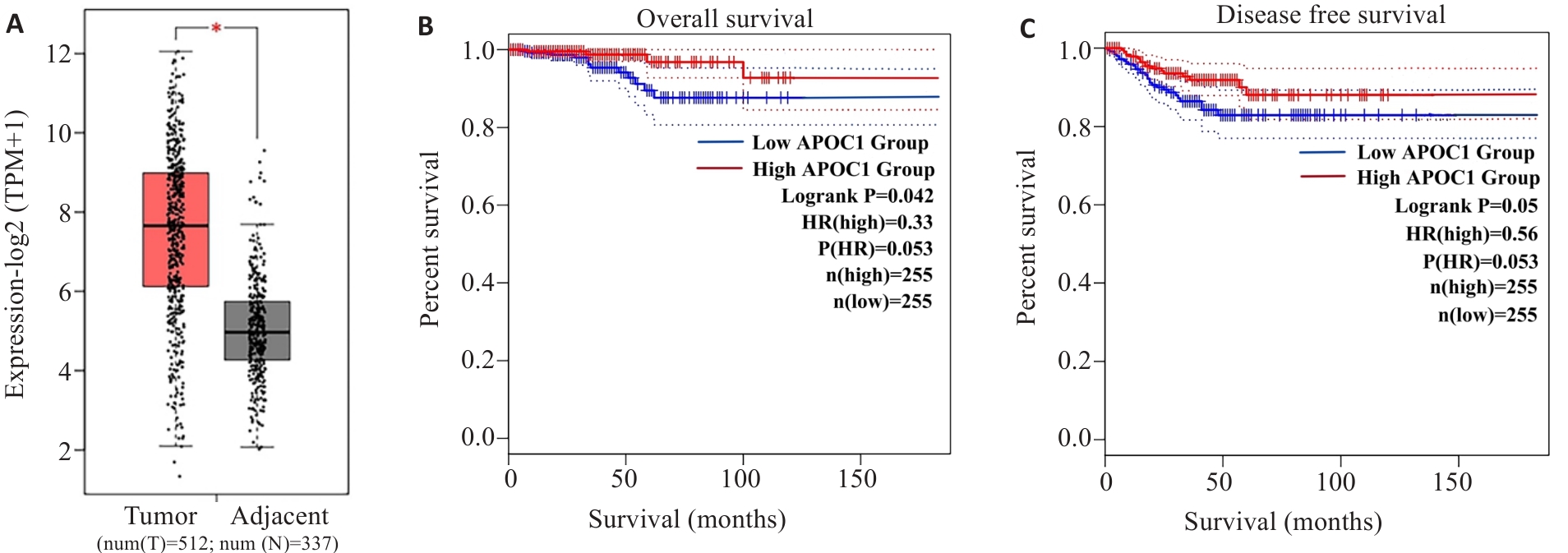
Fig.1 Bioinformatic analysis of APOC1 expression in PTC and Adjacent tissues. A: Analysis of expression levels of APOC1 in PTC tissues and adjacent tissues using GEPIA 2 database (*P<0.05). B, C: Analysis of the relationship between APOC1 mRNA expression and patient prognosis using Kaplan-Meier database.
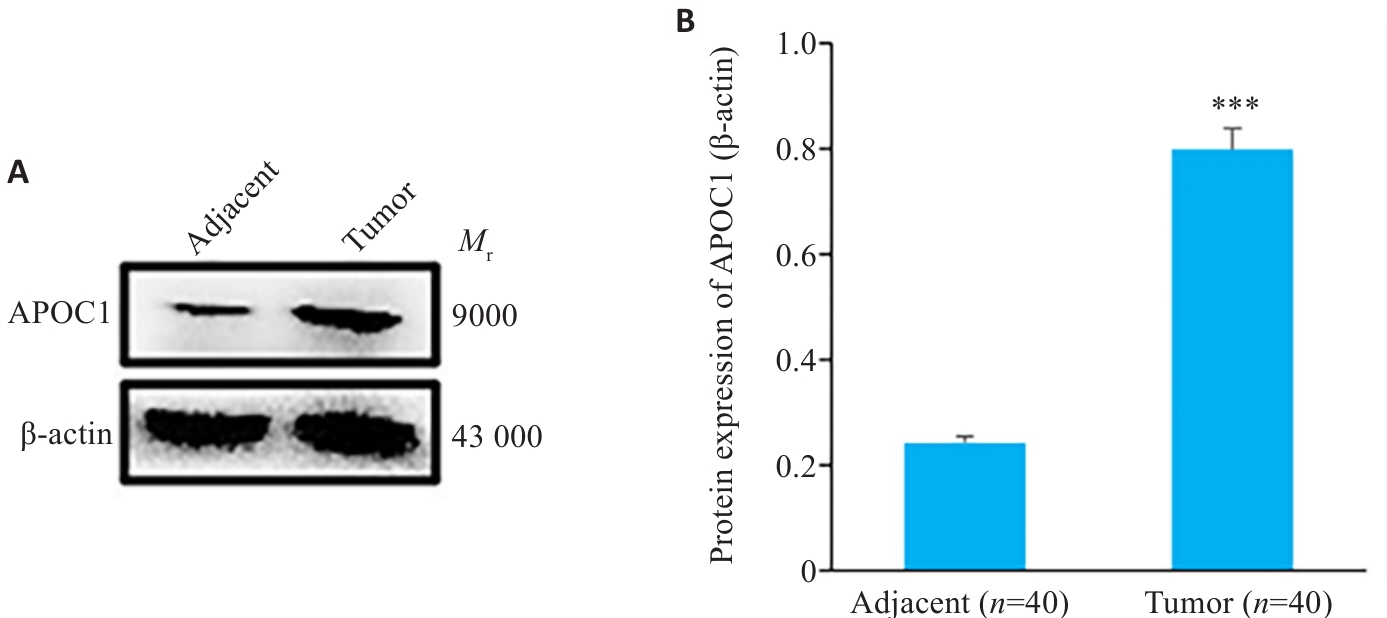
Fig.2 Expression of APOC1 in clinical samples of PTC and adjacent tissues. A: Western blotting for detecting APOC1 expression in PTC tissues and adjacent tissues. B: Quantitative analysis of expression level. ***P<0.001 vs adjacent tissue.
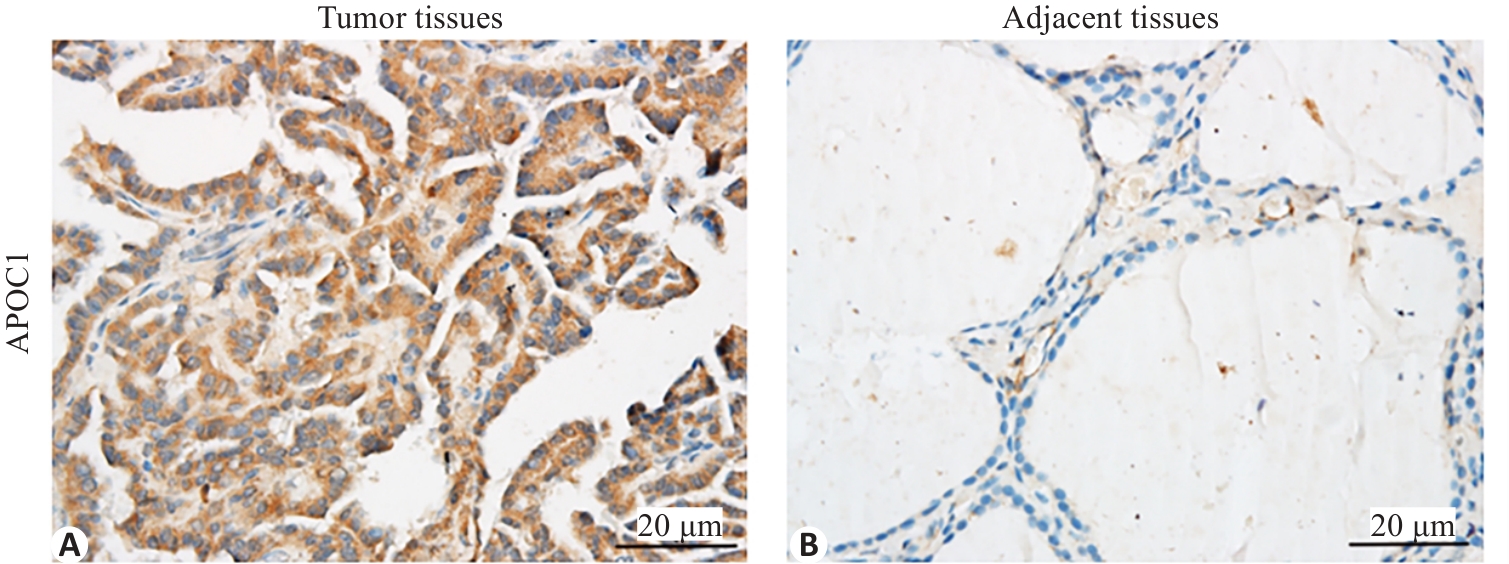
Fig.3 Immunohistochemical detection of APOC1 expression in PTC and Adjacent tissue. A: APOC1 positive signal in PTC tissue (brown) in the cytoplasm. B: Negative expression of APOC1 in adjacent tissue.
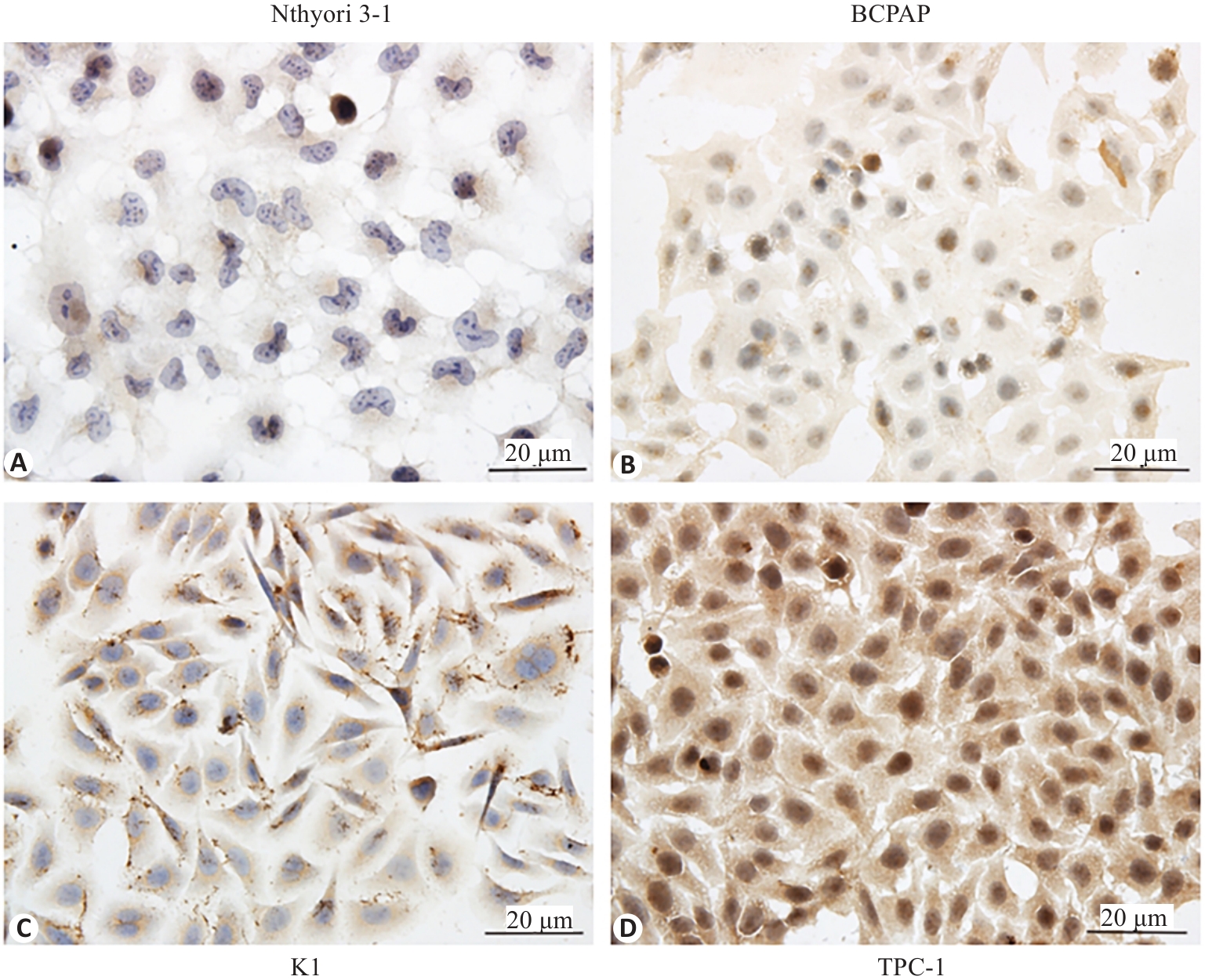
Fig.4 Immunocytochemical detection of APOC1 protein in TPC-1, K1, BCPAP and Nthyori 3-1 cells. A: Negative expression of APOC1 in normal thyiod follicular epithelial Nthyori 3-1 cells. B-D: Positive signals of APOC1 in the 3 PTC cell lines located in the cytoplasm.

Fig.5 Western blotting and RT-qPCR for detecting APOC1 expression in K1, TPC-1, BCPAP and Nthyori 3-1 cells. A,B: Expression levels of APOC1 protein in different cell lines detected by Western blotting. C: Expression levels of APOC1 mRNA in different cell lines. ***P<0.001, ****P<0.0001 vs Nthyori 3-1 cells (n=3).

Fig.6 Expression of APOC1 protein and mRNA in TPC-1 cells with APOC1 knockdown. A,B: Expression levels of APOC1 protein in TPC-1 cells with APOC1 knockdown detected by Western blotting. C: Expression levels of APOC1 mRNA in TPC-1 cells with APOC1 knockdown. *P<0.05, **P<0.01, ***P<0.001, ****P<0.0001 vs shRNAC (n=3).

Fig.7 Decreased APOC1 expressions at both protein and mRNA levels in TPC-1 cells with APOC1 knockdown. A, B: Expression levels of APOC1 protein in shRNAC group, shRNA1 group, and shRNA2 group. C: Expression levels of APOC1 mRNA in the shRNAC group, shRNA1 group, and shRNA2 group. *P<0.05, **P<0.01, ***P<0.001 vs shRNAC (n=3).

Fig.8 Increased APOC1 protein and mRNA levels in BCPAP cells with APOC1 overexpression. A, B: Expression levels of APOC1 protein in OENC and OE groups. C: Expression levels of APOC1 mRNA in OENC and OE groups. **P<0.01, ****P<0.0001 vs OENC (n=3).
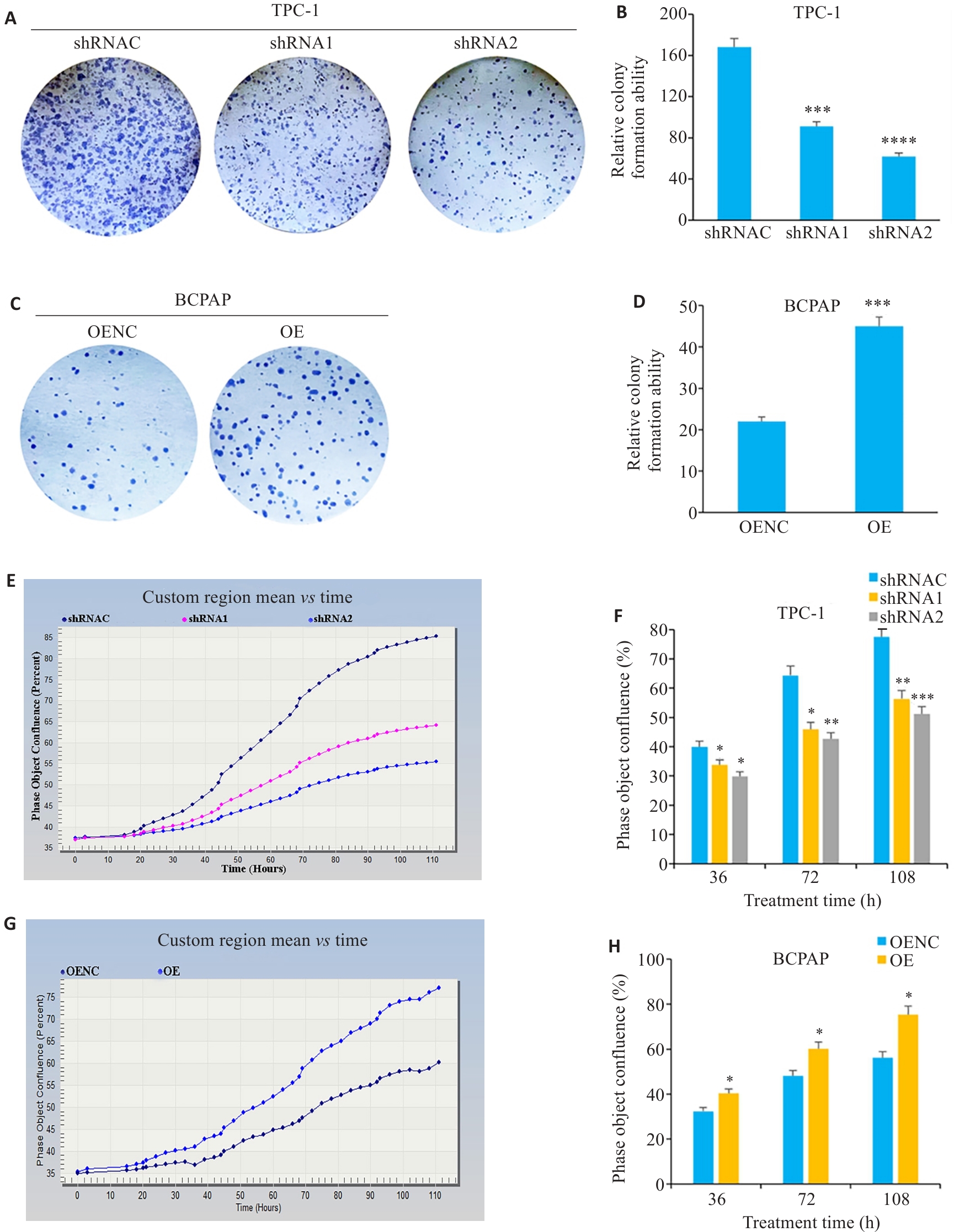
Fig.9 Effect of APOC1 knockdown and overexpresison on PTC cell proliferation. A, C: Colony formation assay of the transfected cells. B,D: Number of cell clusters in the transfected cells. E,G: Growth curves of the transfected cells. F,H: Cell confluence of the transfected cells. *P<0.05,**P<0.01,***P<0.001, ****P<0.001 vs shRNAC/OENC (n=3).
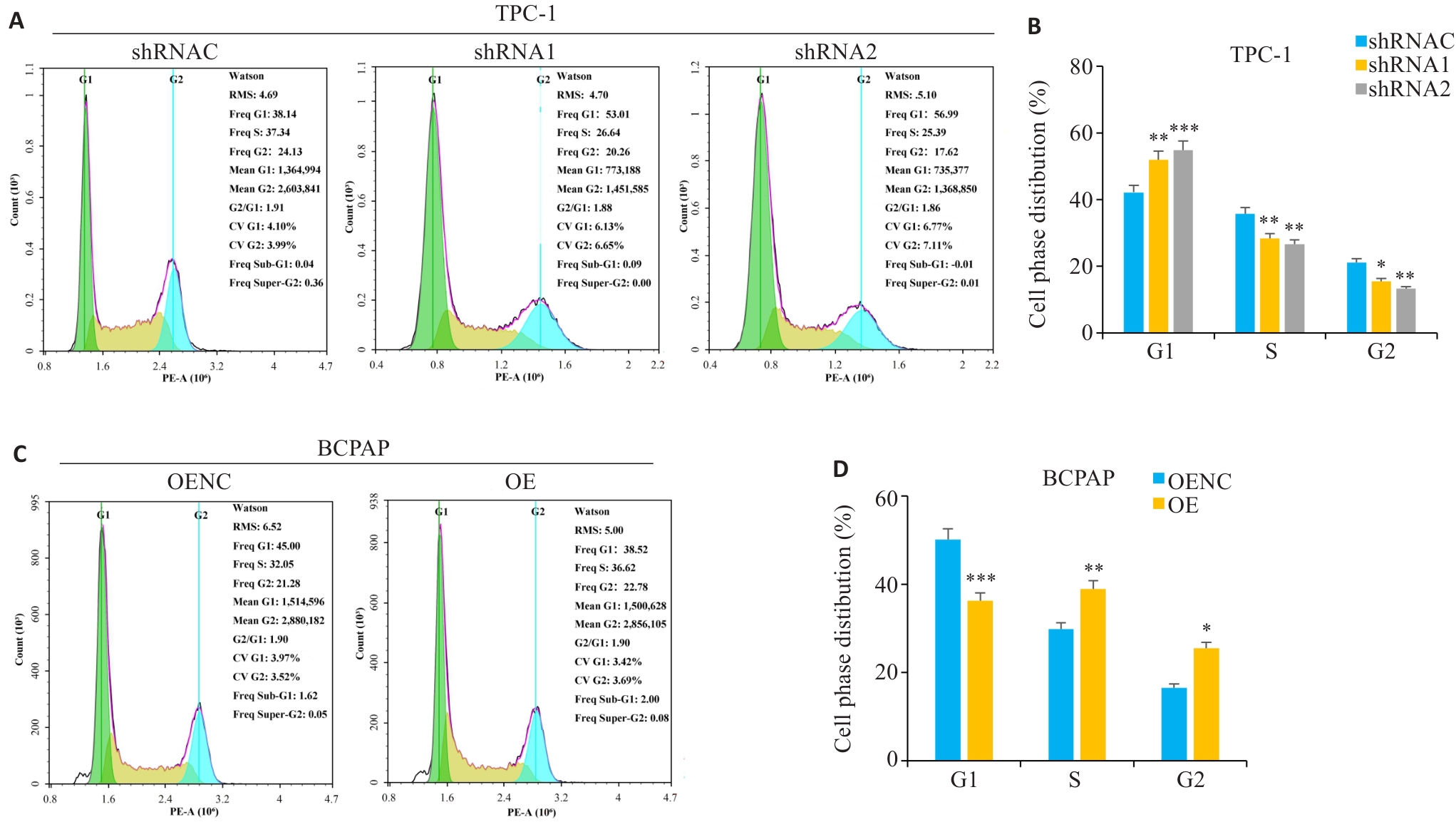
Fig.10 Effect of APOC1 knockdown and overexpresison on cell cycle. A, C: Cell cycle diagrams of the cells with APOC1 knockdown and overexpresison. B, D: Analysis of cell cycle percentage. *P<0.05, **P<0.01, ***P<0.001 vs shRNAC/OENC (n=3).
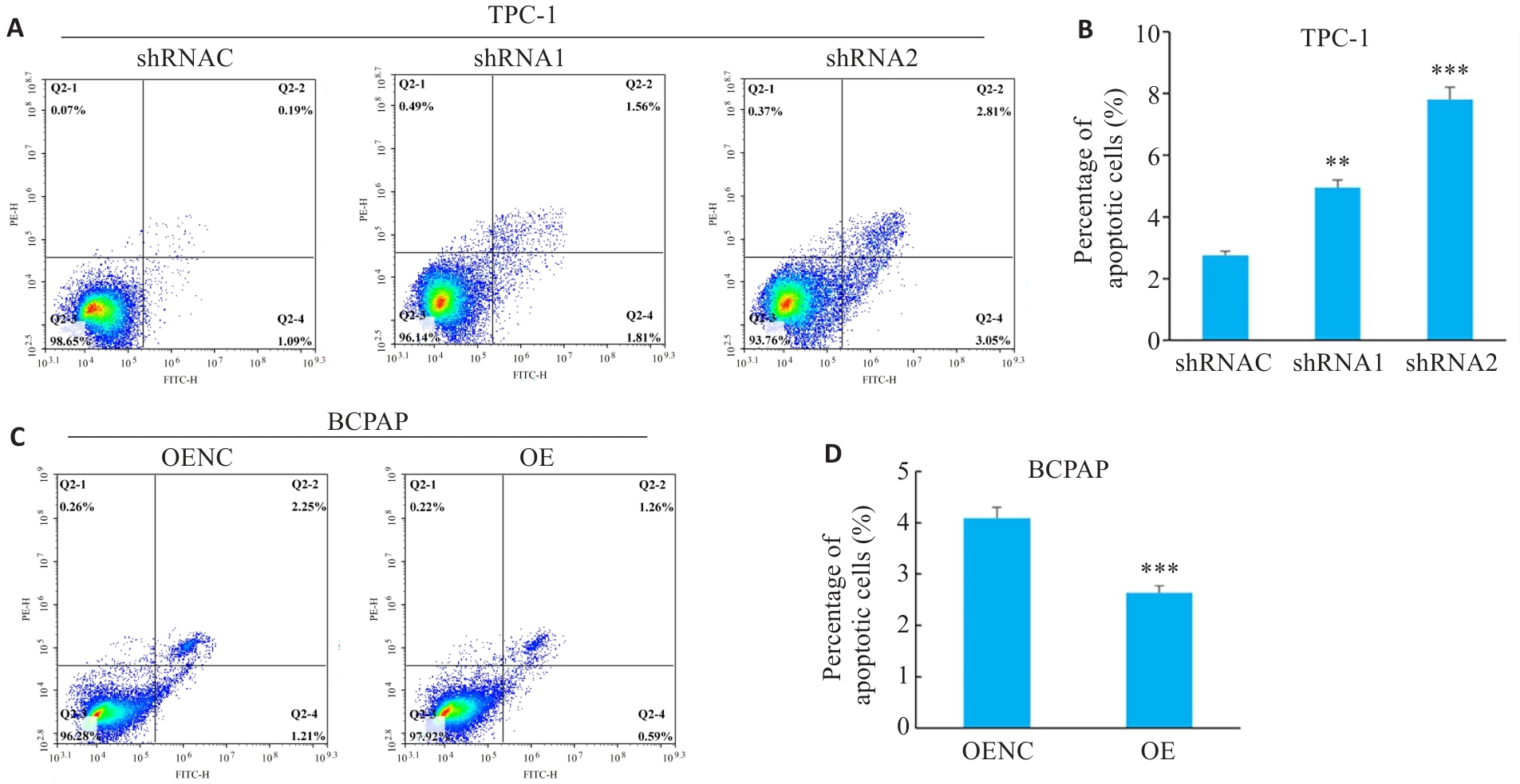
Fig.11 Effect of APOC1 knockdown and overexpresison on cell apoptosis. A,C: Cell apoptosis maps of cells with APOC1 knockdown and overexpresison. B,D: Percentages of apoptotic cells each group.**P<0.01, ***P<0.001 vs shRNAC/OENC (n=3).
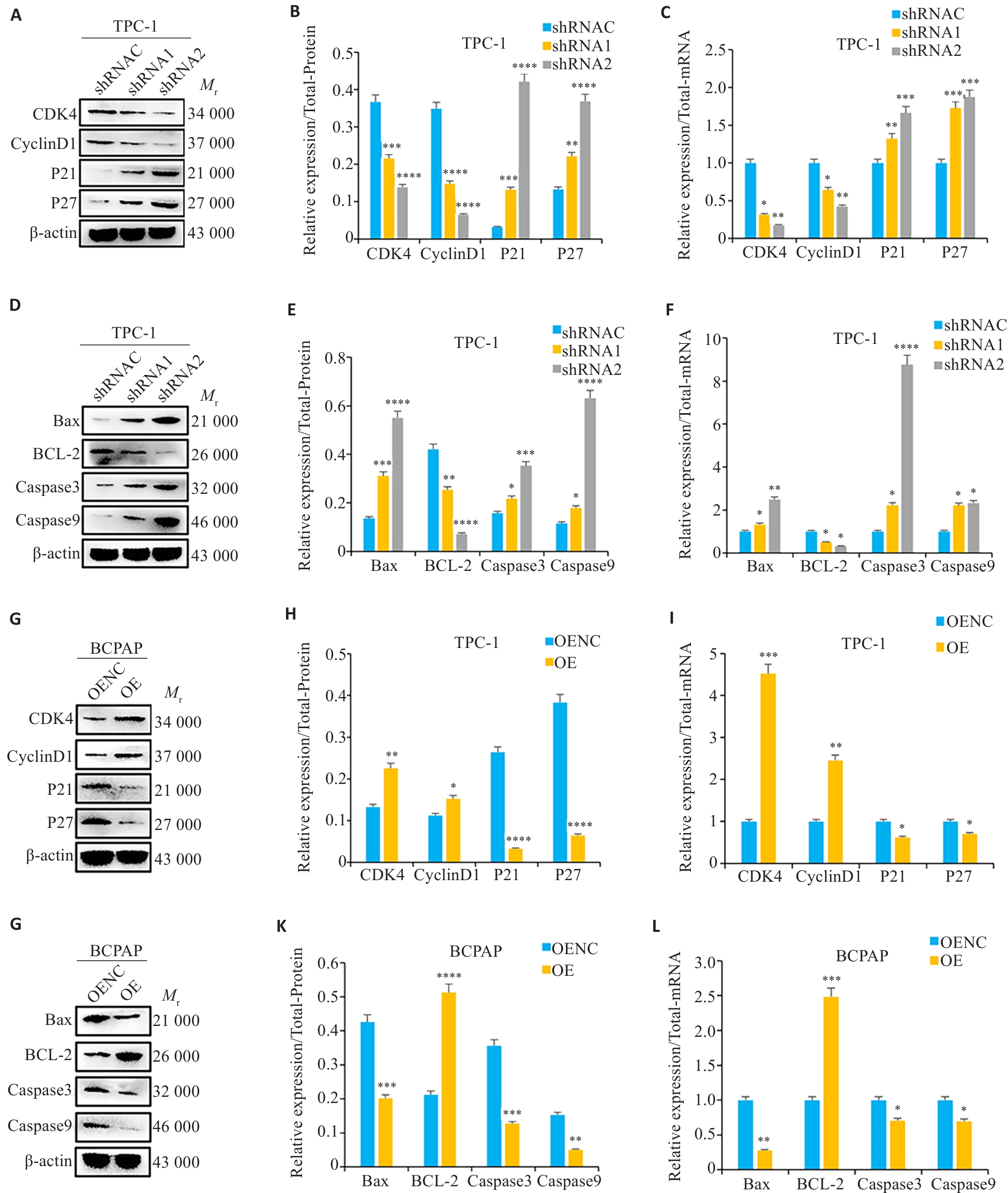
Fig.12 Effect of APOC1 knockdown and overexpresison on expresisons of cell cycle and apoptosis-related proteins and their mRNA levels. A-C: Cell cycle-related protein and mRNA expression levels of in cells with APOC1 knockdown. D-F: Cell cycle-related protein and mRNA expression levels in APOC1 knockdown group. G-I: Apoptosis-related protein and mRNA expression levels in APOC1 overexpression group. J-L: Apoptosis-related protein and mRNA expression levels in APOC1 knockdown group. *P<0.05, **P<0.01,***P<0.001, ****P<0.0001 vs shRNAC/OENC (n=3).
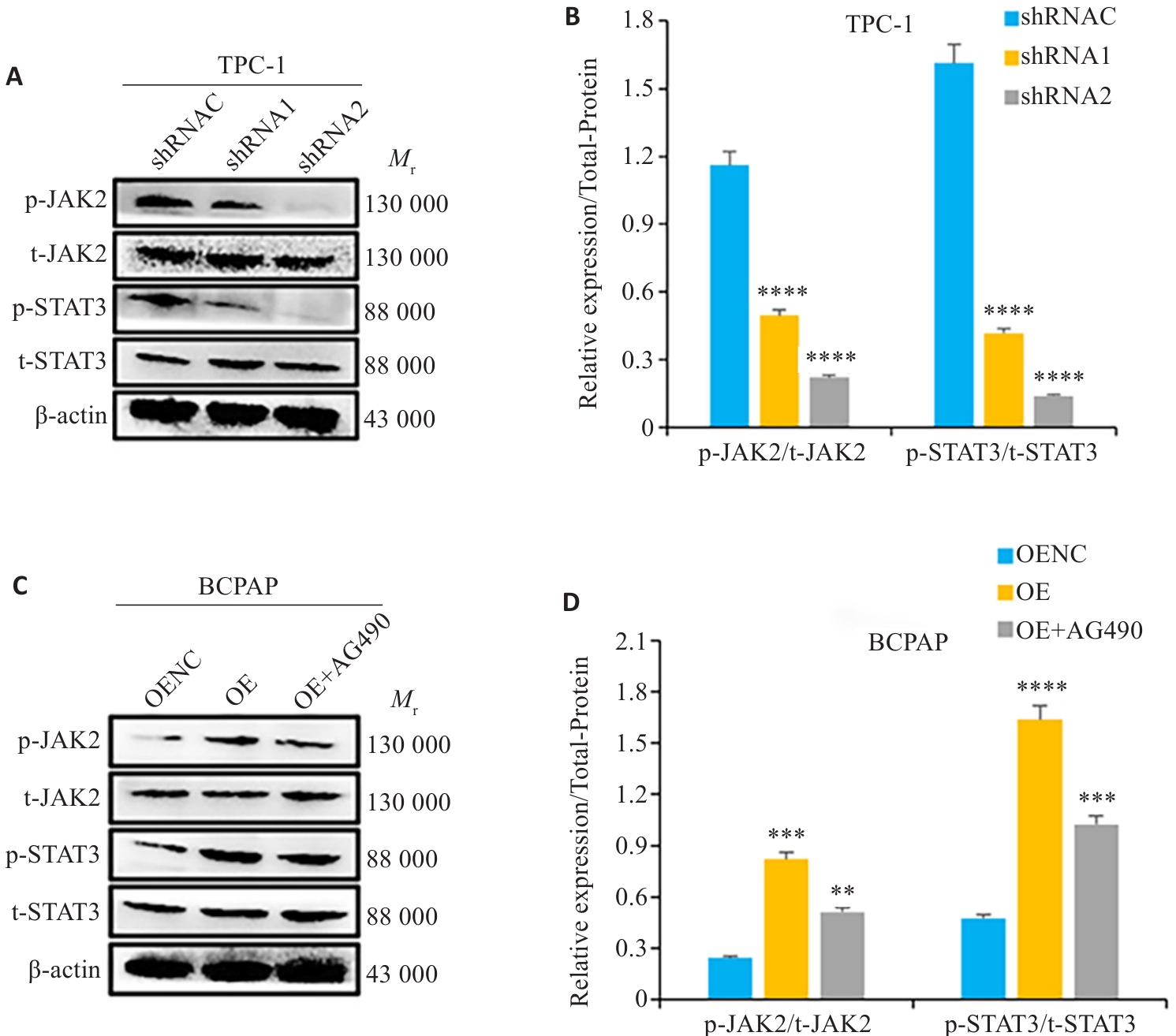
Fig.13 APOC1 knockdown and overexpresison on expressions of key proteins in the JAK2/STAT3 signaling pathway detected by Western blotting. A,B: Expression levels of key proteins in the JAK2/STAT3 signaling pathway in APOC1 knockdown group. C,D: Expression levels of key proteins in the JAK2/STAT3 signaling pathway in APOC1 overexpression group. **P<0.01, ***P<0.001, ****P<0.0001 vs shRNAC/OENC (n=3).
| 1 | 陈一峰, 郑泽荣, 林进吉, 等. 甲状腺乳头状癌合并滤泡癌10例临床病理分析[J]. 临床与实验病理学杂志, 2020, 36(4): 464-6. |
| 2 | Li R, Zhang YJ, Xiang RQ, et al. Analysis of the mechanism of maslinic acid on papillary thyroid carcinoma based on RNA-seq technology[J]. Evid Based Complement Alternat Med, 2022, 2022: 7000531. |
| 3 | Jong MC, Hofker MH, Havekes LM. Role of ApoCs in lipoprotein metabolism: functional differences between ApoC1, ApoC2, and ApoC3[J]. Arterioscler Thromb Vasc Biol, 1999, 19(3): 472-84. |
| 4 | Fuior EV, Gafencu AV. Apolipoprotein C1: its pleiotropic effects in lipid metabolism and beyond[J]. Int J Mol Sci, 2019, 20(23): 5939. |
| 5 | Zhou XP, Chen Y, Mok KY, et al. Non-coding variability at the APOE locus contributes to the Alzheimer's risk[J]. Nat Commun, 2019, 10(1): 3310. |
| 6 | Cao XY, Wu BQ, Guo SM, et al. APOC1 predicts a worse prognosis for esophageal squamous cell carcinoma and is associated with tumor immune infiltration during tumorigenesis[J]. Pathol Oncol Res, 2023, 29: 1610976. |
| 7 | Mei LH, Long J, Wu SE, et al. APOC1 reduced anti-PD-1 immunotherapy of nonsmall cell lung cancer via the transformation of M2 into M1 macrophages by ferroptosis by NRF2/HO-1[J]. Anticancer Drugs, 2024, 35(4): 333-43. |
| 8 | Hao XP, Zheng ZY, Liu HY, et al. Inhibition of APOC1 promotes the transformation of M2 into M1 macrophages via the ferroptosis pathway and enhances anti-PD1 immunotherapy in hepatocellular carcinoma based on single-cell RNA sequencing[J]. Redox Biol, 2022, 56: 102463. |
| 9 | Jiang H, Tang JY, Xue D, et al. Apolipoprotein C1 stimulates the malignant process of renal cell carcinoma via the Wnt3a signaling[J]. Cancer Cell Int, 2021, 21(1): 41. |
| 10 | Yang SM, Du JX, Wang W, et al. APOC1 is a prognostic biomarker associated with M2 macrophages in ovarian cancer[J]. BMC Cancer, 2024, 24(1): 364. |
| 11 | Ren H, Chen ZH, Yang L, et al. Apolipoprotein C1 (APOC1) promotes tumor progression via MAPK signaling pathways in colorectal cancer[J]. Cancer Manag Res, 2019, 11: 4917-30. |
| 12 | Yi J, Ren LW, Wu J, et al. Apolipoprotein C1 (APOC1) as a novel diagnostic and prognostic biomarker for gastric cancer[J]. Ann Transl Med, 2019, 7(16): 380. |
| 13 | Yan Y, Zhou YH, Wang K, et al. Apolipoprotein C1 (APOC1), A candidate diagnostic serum biomarker for breast cancer identified by serum proteomics study[J]. Crit Rev Eukaryot Gene Expr, 2022, 32(4): 1-9. |
| 14 | Lei B, Qian L, Zhang YP, et al. MLAA-34 knockdown shows enhanced antitumor activity via JAK2/STAT3 signaling pathway in acute monocytic leukemia[J]. J Cancer, 2020, 11(23): 6768-81. |
| 15 | 李超友, 罗亚星, 孙新民, 等. 载脂蛋白C1在甲状腺乳头状癌中的临床表达及生物信息学分析[J]. 中国耳鼻咽喉颅底外科杂志, 2021, 27(4): 445-51. |
| 16 | 王培宇, 黄 祺, 王少东, 等. 《全球癌症统计数据2022》要点解读[J]. 中国胸心血管外科临床杂志, 2024, 31(7): 933-54. |
| 17 | Miranda-Filho A, Lortet-Tieulent J, Bray F, et al. Thyroid cancer incidence trends by histology in 25 countries: a population-based study[J]. Lancet Diabetes Endocrinol, 2021, 9(4): 225-34. |
| 18 | Vaccarella S, Franceschi S, Bray F, et al. Worldwide thyroid-cancer epidemic? the increasing impact of overdiagnosis[J]. N Engl J Med, 2016, 375(7): 614-7. |
| 19 | Li MM, Meheus F, Polazzi S, et al. The economic cost of thyroid cancer in France and the corresponding share associated with treatment of overdiagnosed cases[J]. Value Health, 2023, 26(8): 1175-82. |
| 20 | Ishijima T, Nakajima K. Mechanisms of microglia proliferation in a rat model of facial nerve anatomy[J]. Biology, 2023, 12(8): 1121. |
| 21 | Cai ZJ, Wang JR, Li YD, et al. Overexpressed Cyclin D1 and CDK4 proteins are responsible for the resistance to CDK4/6 inhibitor in breast cancer that can be reversed by PI3K/mTOR inhibitors[J]. Sci China Life Sci, 2023, 66(1): 94-109. |
| 22 | Coqueret O. New roles for p21 and p27 cell-cycle inhibitors: a function for each cell compartment[J]? Trends Cell Biol, 2003, 13(2): 65-70. |
| 23 | 王钦磊. APOC1通过Wnt/β-catenin信号通路诱导G0/G1期阻滞抑制胆管癌细胞增殖的机制研究[D]. 青岛: 青岛大学, 2024. |
| 24 | Pu HC, Qian Q, Wang FL, et al. Schizandrin A induces the apoptosis and suppresses the proliferation, invasion and migration of gastric cancer cells by activating endoplasmic reticulum stress[J]. Mol Med Rep, 2021, 24(5): 787. |
| 25 | Zhang Y, Yang X, Ge XH, et al. Puerarin attenuates neurological deficits via Bcl-2/Bax/cleaved caspase-3 and Sirt3/SOD2 apoptotic pathways in subarachnoid hemorrhage mice[J]. Biomed Pharmacother, 2019, 109: 726-33. |
| 26 | Guan HM, Li WQ, Liu J, et al. LncRNA HIF1A-AS2 modulated by HPV16 E6 regulates apoptosis of cervical cancer cells via P53/caspase9/caspase3 axis[J]. Cell Signal, 2022, 97: 110390. |
| 27 | Takano S, Yoshitomi H, Togawa A, et al. Apolipoprotein C-1 maintains cell survival by preventing from apoptosis in pancreatic cancer cells[J]. Oncogene, 2008, 27(20): 2810-22. |
| 28 | 宋慧娟, 徐振华, 何东宁. 载脂蛋白C1表达对人肝癌HepG2细胞增殖和凋亡的影响及其机制[J]. 吉林大学学报: 医学版, 2024, 50(1): 128-35. |
| 29 | Li RJ, He HX, He XX. APOC1 promotes the progression of osteosarcoma by binding to MTCH2[J]. Exp Ther Med, 2023, 25(4): 163. |
| 30 | 余以珊. APOC1通过MAPK/ERK通路促进食管鳞状细胞癌增殖及转移的机制研究[D]. 济南: 山东大学, 2023. |
| 31 | Gao FF, Chen JL, Zhang TT, et al. LPCAT1 functions as an oncogene in cervical cancer through mediating JAK2/STAT3 signaling[J]. Exp Cell Res, 2022, 421(1): 113360. |
| 32 | Judd LM, Menheniott TR, Ling H, et al. Inhibition of the JAK2/STAT3 pathway reduces gastric cancer growth in vitro and in vivo [J]. PLoS One, 2014, 9(5): e95993. |
| 33 | Fu LX, Lian QW, Pan JD, et al. JAK2 tyrosine kinase inhibitor AG490 suppresses cell growth and invasion of gallbladder cancer cells via inhibition of JAK2/STAT3 signaling[J]. J Biol Regul Homeost Agents, 2017, 31(1): 51-8. |
| 34 | Brooks AJ, Putoczki T. JAK-STAT signalling pathway in cancer[J]. Cancers, 2020, 12(7): 1971. |
| 35 | Xing ZY, Wang X, Liu JQ, et al. Effect of miR-210 on the chemosensitivity of breast cancer by regulating JAK-STAT signaling pathway[J]. Biomed Res Int, 2021, 2021: 7703159. |
| 36 | Cheng X, PKKYeung, Zhong K, et al. Astrocytic endothelin-1 overexpression promotes neural progenitor cells proliferation and differentiation into astrocytes via the Jak2/Stat3 pathway after stroke[J]. J Neuroinflammation, 2019, 16(1): 227. |
| 37 | Yin Z, Ma TT, Lin Y, et al. IL-6/STAT3 pathway intermediates M1/M2 macrophage polarization during the development of hepatocellular carcinoma[J]. J Cell Biochem, 2018, 119(11): 9419-32. |
| 38 | Kim MS, Lee WS, Jeong J, et al. Induction of metastatic potential by TrkB via activation of IL6/JAK2/STAT3 and PI3K/AKT signaling in breast cancer[J]. Oncotarget, 2015, 6(37): 40158-71. |
| 39 | Zhou JM, Wu A, Yu XT, et al. SIRT6 inhibits growth of gastric cancer by inhibiting JAK2/STAT3 pathway[J]. Oncol Rep, 2017, 38(2): 1059-66. |
| 40 | Carpenter RL, Lo HW. STAT3 target genes relevant to human cancers[J]. Cancers, 2014, 6(2): 897-925. |
| 41 | Wang JQ, Zhang Y, Song H, et al. The circular RNA circSPARC enhances the migration and proliferation of colorectal cancer by regulating the JAK/STAT pathway[J]. Mol Cancer, 2021, 20(1): 81. |
| 42 | Li YJ, Wei J, Sun Y, et al. DLGAP5 regulates the proliferation, migration, invasion, and cell cycle of breast cancer cells via the JAK2/STAT3 signaling axis[J]. Int J Mol Sci, 2023, 24(21): 15819. |
| [1] | Di CHEN, Ying LÜ, Yixin GUO, Yirong ZHANG, Ruixuan WANG, Xiaoruo ZHOU, Yuxin CHEN, Xiaohui WU. Dihydroartemisinin enhances doxorubicin-induced apoptosis of triple negative breast cancer cells by negatively regulating the STAT3/HIF-1α pathway [J]. Journal of Southern Medical University, 2025, 45(2): 254-260. |
| [2] | Jinhua ZOU, Hui WANG, Dongyan ZHANG. SLC1A5 overexpression accelerates progression of hepatocellular carcinoma by promoting M2 polarization of macrophages [J]. Journal of Southern Medical University, 2025, 45(2): 269-284. |
| [3] | Xiaohua CHEN, Hui LU, Ziliang WANG, Lian WANG, Yongsheng XIA, Zhijun GENG, Xiaofeng ZHANG, Xue SONG, Yueyue WANG, Jing LI, Jianguo HU, Lugen ZUO. Role of Abelson interactor 2 in progression and prognosis of gastric cancer and its regulatory mechanisms [J]. Journal of Southern Medical University, 2024, 44(9): 1653-1661. |
| [4] | Liangjun XUE, Qiuyu TAN, Jingwen XU, Lu FENG, Wenjin LI, Liang YAN, Yulei LI. MiR-6838-5p overexpression inhibits proliferation of breast cancer MCF-7 cells by downregulating DDR1 expression [J]. Journal of Southern Medical University, 2024, 44(9): 1677-1684. |
| [5] | Kai JI, Guanyu YU, Leqi ZHOU, Tianshuai ZHANG, Qianlong LING, Wenjiang MAN, Bing ZHU, Wei ZHANG. HNRNPA1 gene is highly expressed in colorectal cancer: its prognostic implications and potential as a therapeutic target [J]. Journal of Southern Medical University, 2024, 44(9): 1685-1695. |
| [6] | Yidan PANG, Ya LIU, Siai CHEN, Jinglei ZHANG, Jin ZENG, Yuanming PAN, Juan AN. Biological role of SPAG5 in the malignant proliferation of gastric cancer cells [J]. Journal of Southern Medical University, 2024, 44(8): 1497-1507. |
| [7] | Shuo LIU, Jing LI, Xingwang WU. Swertiamarin ameliorates 2,4,6-trinitrobenzenesulfonic acid-induced colitis in mice by inhibiting intestinal epithelial cell apoptosis [J]. Journal of Southern Medical University, 2024, 44(8): 1545-1552. |
| [8] | Xiaofan CONG, Teng CHEN, Shuo LI, Yuanyuan WANG, Longyun ZHOU, Xiaolong LI, Pei ZHANG, Xiaojin SUN, Surong ZHAO. Dihydroartemisinin enhances sensitivity of nasopharyngeal carcinoma HNE1/DDP cells to cisplatin-induced apoptosis by promoting ROS production [J]. Journal of Southern Medical University, 2024, 44(8): 1553-1560. |
| [9] | Linyu XIAO, Ting DUAN, Yongsheng XIA, Yue CHEN, Yang SUN, Yibo XU, Lei XU, Xingzhou YAN, Jianguo HU. Linarin inhibits microglia activation-mediated neuroinflammation and neuronal apoptosis in mouse spinal cord injury by inhibiting the TLR4/NF-κB pathway [J]. Journal of Southern Medical University, 2024, 44(8): 1589-1598. |
| [10] | Mengdong ZHENG, Yan LIU, Jiaojiao LIU, Qiaozhen KANG, Ting WANG. Effect of deletion of protein 4.1R on proliferation, apoptosis and glycolysis of hepatocyte HL-7702 cells [J]. Journal of Southern Medical University, 2024, 44(7): 1355-1360. |
| [11] | Yuanguo WANG, Peng ZHANG. Ferroptosis suppressor genes are highly expressed in esophageal cancer to inhibit tumor cell ferroptosis [J]. Journal of Southern Medical University, 2024, 44(7): 1389-1396. |
| [12] | Zhijun REN, Jianxin DIAO, Yiting WANG. Xionggui Decoction alleviates heart failure in mice with myocardial infarction by inhibiting oxidative stress-induced cardiomyocyte apoptosis [J]. Journal of Southern Medical University, 2024, 44(7): 1416-1424. |
| [13] | Huaxing HE, Lulin LIU, Yingyin LIU, Nachuan CHEN, Suxia SUN. Sodium butyrate and sorafenib synergistically inhibit hepatocellular carcinoma cells possibly by inducing ferroptosis through inhibiting YAP [J]. Journal of Southern Medical University, 2024, 44(7): 1425-1430. |
| [14] | Guiling CHEN, Xiaofeng LIAO, Pengtao SUN, Huan CEN, Shengchun SHU, Bijing LI, Jinhua LI. Solasonine promotes apoptosis of non-small cell lung cancer cells by regulating the Bcl-2/Bax/caspase-3 pathway [J]. Journal of Southern Medical University, 2024, 44(6): 1109-1116. |
| [15] | Jincun FANG, Liwei LIU, Junhao LIN, Fengsheng CHEN. Overexpression of CDHR2 inhibits proliferation of breast cancer cells by inhibiting the PI3K/Akt pathway [J]. Journal of Southern Medical University, 2024, 44(6): 1117-1125. |
| Viewed | ||||||
|
Full text |
|
|||||
|
Abstract |
|
|||||